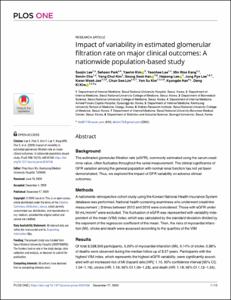KUMEL Repository
1. Journal Papers (연구논문)
1. School of Medicine (의과대학)
Dept. of Internal Medicine (내과학)
Impact of variability in estimated glomerular filtration rate on major clinical outcomes: A nationwide population-based study
- Keimyung Author(s)
- Kim, Yae Rim
- Department
- Dept. of Internal Medicine (내과학)
- Journal Title
- PLoS One
- Issued Date
- 2020
- Volume
- 15
- Issue
- 12
- Abstract
- Background:
The estimated glomerular filtration rate (eGFR), commonly estimated using the serum creatinine value, often fluctuates throughout the serial measurement. The clinical significance of GFR variation among the general population with normal renal function has not yet been demonstrated. Thus, we explored the impact of GFR variability on adverse clinical outcomes.
Methods:
A nationwide retrospective cohort study using the Korean National Health Insurance System database was performed. National health screening examinees who underwent creatinine measurement ≥3 times between 2012 and 2016 were considered. Those with eGFR under 60 mL/min/m2 were excluded. The fluctuation of eGFR was represented with variability independent of the mean (VIM) index; which was calculated by the standard deviation divided by the exponent of the regression coefficient of the mean. Then, the risks of myocardial infarction (MI), stroke and death were assessed according to the quartiles of the VIM
Results:
Of total 3,538,500 participants, 0.29% of myocardial infarction (MI), 0.14% of stroke, 0.36% of deaths were observed during the median follow up of 3.27 years. Participants with the highest VIM index, which represents the highest eGFR variability, were significantly associated with an increased risk of MI (hazard ratio [HR]; 1.10, 95% confidence interval [95% CI]; 1.04–1.16), stroke (HR: 1.16; 95% CI 1.09–1.23), and death (HR: 1.18; 95% CI 1.12–1.24). The elevated risk of adverse events was consistent after the multivariate adjustment with potential confounding factors, except the risk of MI (HR 1.06; 95% 1.00–1.06).
Conclusions:
Increased eGFR variability exhibited an association with major clinical outcomes, indicating that monitoring eGFR variability might be a useful parameter for predicting the adverse outcomes.
- Keimyung Author(s)(Kor)
- 김예림
- Publisher
- School of Medicine (의과대학)
- Citation
- Soojin Lee et al. (2020). Impact of variability in estimated glomerular filtration rate on major clinical outcomes: A nationwide population-based study. PLoS One, 15(12), e0244156. doi: 10.1371/journal.pone.0244156
- Type
- Article
- ISSN
- 1932-6203
- Source
- https://journals.plos.org/plosone/article?id=10.1371/journal.pone.0244156
- Appears in Collections:
- 1. School of Medicine (의과대학) > Dept. of Internal Medicine (내과학)
- 파일 목록
-
-
Download
 oak-2020-0784.pdf
기타 데이터 / 600.29 kB / Adobe PDF
oak-2020-0784.pdf
기타 데이터 / 600.29 kB / Adobe PDF
-
Items in Repository are protected by copyright, with all rights reserved, unless otherwise indicated.